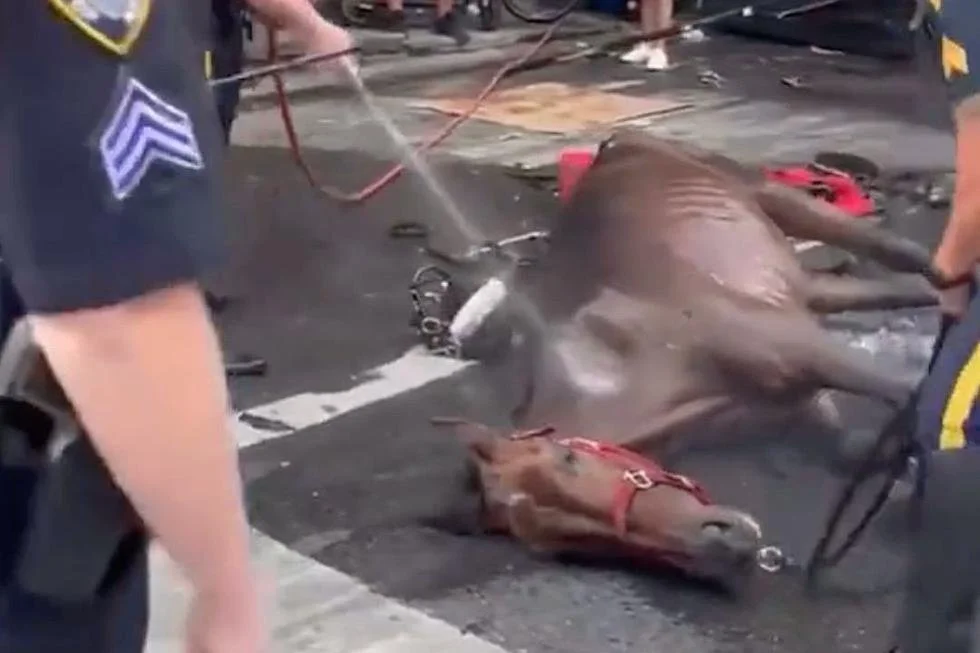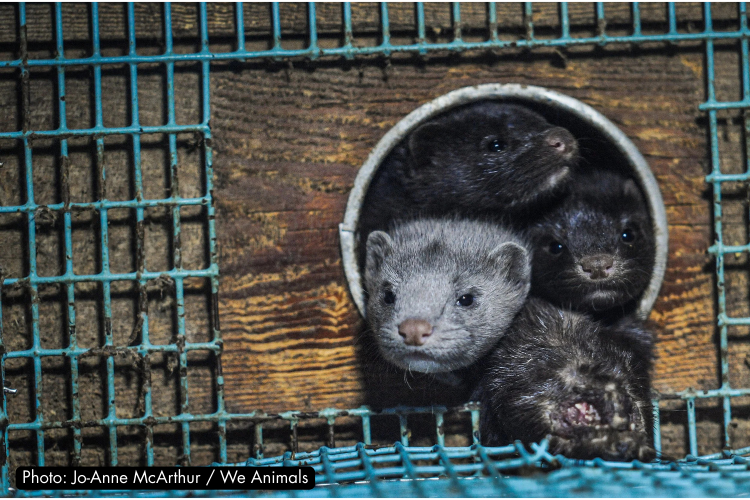New York carriage driver found not guilty after collapse of horse Ryder
Collapsed Ryder in the viral footage. Credit: Voters For Animal Rights
In 40 minutes, six New York jurors decided that carriage horse driver, Ian McKeever, was not guilty of overdriving his horse, Ryder, who collapsed on August 2022 and was euthanized two months later.
The jurors heard 15 witnesses, and watched several hours of videotape including NYPD body-cam footage. Post-verdict, juror Tracy Winston told Species Unite that the pictures and videos were the most compelling bits of evidence he saw.
The five-day trial is historic; never before has a New York City carriage horse driver been arrested, charged and forced to defend how he treats sentient “property” in criminal court.
After Ryder collapsed in 2022, footage of the horse lying in traffic, surrounded by police and an angry crowd, went viral, prompting public outrage, calls for prosecution, and renewed efforts to ban New York City’s long-controversial carriage horse industry.
Three years later, the case finally went to court.
Throughout the trial there was contention about Ryder’s age. Racing horse trainer, Michael Petrelli stated in an email that “All standardbreds have freeze brands on the side of their neck.”
Ryder’s freeze brand indicated he was born in 1996 and was 26 years old when he collapsed. That freeze brand was not entered as evidence.
The jury never heard that Ryder’s NYC records were falsified.
Stable manager Anthony Salerno testified that he knew defendant "Ian McKeever and his brother Colm McKeever for 30 years." All three drove, bought and sold carriage horses, and presumably knew that NYC regulations require carriage horses to be retired by age 27 - the equivalent of 80 to 90 in human years. Yet on his NYC license application for Ryder, Colm McKeever listed Ryder as 13 years old, instead of his real age of 26.
Had Ryder not collapsed in Manhattan’s rush hour traffic, Colm McKeever's deception regarding Ryder's age may have remained unknown and Colm would not have been forced to pay a $1,000 fine for falsifying NYC business records.
But police officers of NYPD’s mounted unit agreed that Ryder was far older than 13, which is what Defendant McKeever told them when they arrived on the scene. Veterinarians of both sides, called to testify as experts, agreed that Ryder was 26. On cross examination, the defendant’s own veterinarian, Camilo Sierra admitted that he originally assessed Ryder at 28 to 30 years old, before changing the medical record to NYC’s legal maximum of 26.
“He was pushed beyond his limit; ultimately, he couldn’t even stand.”
Defendant McKeever testified Friday that Ryder tripped while changing lanes. But first responder Sargent Fontana, of NYPD’s mounted police, described hosing an "exhausted, sweaty" horse who needed nearly an hour of ice and cold water before rising to be guided into the NYPD equine ambulance. “This was not a simple case of a horse falling," Fontana stated.
In addition, Defendant McKeever testified that Ryder showed no signs of distress during his seven-hour day. Yet four hours before he collapsed, Ryder appeared slow and struggling in Central Park. Caroline Londahl-Smidt testified that her attention was drawn to a panting horse in "major distress" 15-20 feet away. “You could see how hard he was struggling" she said. "When he turned right, I saw all his ribs.”
Forensic veterinarian Dr. Niestet examined Ryder shortly before he was euthanized and testified that Ryder was “emaciated”, with little to no body fat on his back, ribs, hips and hind quarters. “He should not have been working that day, that week, or that month,” she told the jury. Asked if cancer caused Ryder’s collapse on August 10, 2022, Dr. Niestet replied that leukemia was “a contributing factor, but not the only cause” of Ryder’s collapse. “He was pushed beyond his limit,” she said; “ultimately, he couldn’t even stand.”
That Ryder had leukemia was acknowledged by both sides; Ryder’s Cornell diagnostics indicated abnormalities in September and his October necropsy proved it. Witness and carriage horse driver Christina Hansen explained post-trial that: “(t)he first symptom of leukemia is weight loss, often rapid. Ryder certainly had cancer when he tripped and fell, though no one had any reason to suspect that, and he probably had it before he even arrived to New York City in April 2022.”
For juror Tracy Winston, the presence of undiagnosed cancer was “a game changer.” Juror Winston approached Defendant McKeever outside the courthouse to ask: “If you knew Ryder was sick, would you have taken him out that day?” “Absolutely not,” replied McKeever. “I did not know he had cancer.”
Ryder is the most famous, but not the only NYC carriage horse who collapsed from heat exhaustion. Defendant McKeever testified that he’s had “one or two” horses suffer heat exhaustion and “20-25 horses trip over” during his years as a carriage horse driver.
This does not include the many horses who have spooked and run into traffic, hurting themselves and others. Just this May, Species Unite reported that “two horse-drawn carriages collided with each other in Central Park, hospitalizing both carriage operators.”
“Horses are large prey animals” explained Donny Moss, documentary filmmaker of BLINDERS: The Truth Behind the Tradition. “Loud music, police sirens, even an umbrella popping open can spook them.”
That’s what frightened a Percheron gelding named Arthur in February 2018. Startled by an opening umbrella, Arthur fled down 6th Avenue carrying three screaming Texan tourists.
“Given Manhattan’s climate, composition and architecture, it is inherently impossible to have a humane carriage operation.”
Less dramatic but equally deadly is the daily nose-to-tailpipe existence of Manhattan carriage horses. Running alongside buses, taxis and idling traffic, “increases the likelihood of heaves (chronic obstructive respiratory disease),” said veterinarian Holly Cheever. "Given Manhattan's climate, composition and architecture, it is inherently impossible to have a humane carriage operation."
Ryder’s Law
71% of New Yorkers want a horse carriage ban; so why has the bill to ban horse drawn carriages (named “Ryder's Law”) stalled in NYC Council?
Councilman and bill sponsor, Robert Holden, explained: “Unfortunately, many of my colleagues are feckless and view every issue through a political lens rather than asking whether it's the right thing to do. Too many are afraid of upsetting powerful special interests, prioritize their own political futures, and lack the courage to stand up against an inhumane industry that should have been banned long ago.”
Elizabeth Forel, President of Coalition for NYC Animals, agreed. “Many NYC Councilmembers who were willing to support a ban of horse-drawn carriages changed their mind when the Transit Workers Union endorsed and extended protected to the industry.”
Edita Birnkrant of NYCLASS (New Yorkers for Clean and Safe Streets) did not mince words: “I'm disgusted. Several NYC Council members who have pledged to ban horse carriages now refuse to sign Ryder's Law because they are being lobbied by the TWU Local 100, which represents owners like Ian McKeever.”
What can you do?
While the trial may not have delivered the verdict animal advocates were hoping for, it has reignited public outrage and renewed calls to pass Ryder’s Law. We owe it to Ryder and every horse still working the streets to turn this momentum into lasting change. Please join 7,929 other Species Unite supporters in urging New York councilors to end the horse drawn carriage industry and pass Ryder’s Law. Add your name to the petition here.
Written by Tamara Bedić
Tamara Bedić, Esq. is a New York attorney, championing women in the workplace. When she's not litigating, she is rescuing injured birds, chairing the Animal Rights Committee of the National Lawyers Guild or walking her special needs cat, ILLYA.
We Have A Favor To Ask…
Species Unite amplifies well-researched solutions to some of the most abusive animal industries operating today.
At this crucial moment, with worldwide momentum for change building, it’s vital we share these animal-free solutions with the world - and we need your help.
We’re a nonprofit, and so to keep sharing these solutions, we’re relying on you - with your support, we can continue our essential work in growing a powerful community of animal advocates this year.








